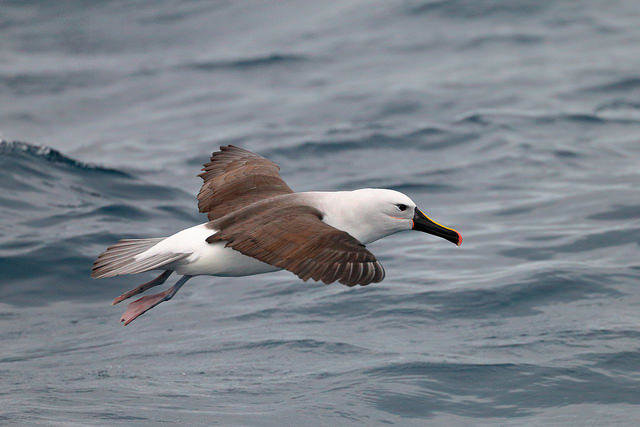
© Ed Dunens Yellow-nosed Albatross
Already one of the great seabird watching locations in the world, Cape Cod recently produced yet another staggering record. Following last weekend's storm, a Yellow-nosed Albatross was spotted doing what albatrosses do, casually gliding around in the wicked winds off First Encounter Beach in Eastham.
First Encounter has long been known in the birding world as the place to be following the passage of a Nor'easter, and the legendary location came through again.
During a Nor'easter, seabirds that would normally be well offshore get blown into Cape Cod Bay, where they wait for the right conditions to exit the bay and head back out to sea. During the easterly blow, the north facing beach at Sandy Neck in Barnstable is a good place to see these birds as they struggle to fly into the strong headwinds. But when the storm has passed and the winds shift to the northwest, the west-facing First Encounter offers the best chance to see birds typically difficult or impossible to see from land in this part of the world, and often right off the beach. Everything from puffins to rare Caribbean petrels have passed this beach over the years.
And this is the second Yellow-nosed Albatross for First Encounter, the last one recorded in 2003. Local sea birding legend Blair Nikula is responsible for both of these records
Albatrosses hold a special place in the hearts of local birders, because of their rarity in the North Atlantic, which has no regularly occurring albatross species, and also because of their general impressiveness as animals. They are way bigger than other seabirds, sporting the longest wing spans of any living bird. The Wandering Albatross would have given a pterodactyl a fright, with wings spanning almost 12 feet. And albatrosses use these wings to great effect, gliding effortlessly for days at a time as they cover huge areas of ocean. One satellite tracked Wandering Albatross traveled over 3000 miles of ocean in 12 days, and others commute 2000 miles a week between their nests and feeding areas when raising their young.
From wing span to life span, these birds present a veritable cornucopia of natural history extremes. A Laysan Albatross named Wisdom was banded on Midway Atoll in the Pacific Ocean in 1956, when she was at least 5 years old. This almost septuagenarian is still alive and nesting on Midway today, having dodged threats like long-line fisheries and plastic ingestion that currently threaten albatross populations worldwide. Albatrosses feed on squid, fish, and crustaceans on the ocean surface, often at night, when they ingest the plastic trash that has collected in certain areas of the oceans, which they then feed to their chicks. Now iconic photos of the plastic-filled remains of the many dead albatross chicks on Midway have acutely illustrated the problem of plastic in our oceans.
Here in New England we are just happy to see the very occasional albatross visiting from the southern hemisphere oceans they normally haunt. History tells us you are not likely to find one, and even when they do turn up, they are not seen again. Given the ground they can cover, this bird could be halfway to Europe by now. But even the slimmest chance of seeing one of these most impressive animals should be enough to draw you out to your local seawatching spot, because it may be a decade before we see another.
Reader Comments
to our Newsletter